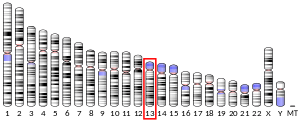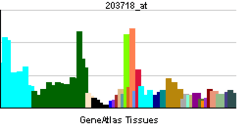5-lipoxygenase-activating protein
Arachidonate 5-lipoxygenase-activating protein also known as 5-lipoxygenase activating protein, or FLAP, is a protein that in humans is encoded by the ALOX5AP gene.[5][6]
Function
FLAP is necessary for the activation of 5-lipoxygenase and therefore for the production of leukotrienes, 5-hydroxyeicosatetraenoic acid, 5-oxo-eicosatetraenoic acid, and specialized pro-resolving mediators of the lipoxin and resolvin classes.[7][8] It is an integral protein within the nuclear membrane. FLAP is necessary in synthesis of leukotriene, which are lipid mediators of inflammation that is involved in respiratory and cardiovascular diseases. FLAP functions as a membrane anchor for 5-lipooxygenase and as an amine acid-bind protein. How FLAP activates 5-lipooxygenase is not completely understood, but there is a physical interaction between the two. FLAP structure consist of 4 transmembrane alpha helices, but they are found in 3’s( trimer) forming a barrel. The barrel is about 60 A high and 36 A wide.[9]
Clinical significance
Gene polymorphisms in FLAP are suspected of playing a role in Alzheimer's disease.[10] Leukotrienes, which need the FLAP protein to be made, have an established pathological role in allergic and respiratory diseases. Animal and human genetic evidence suggests they may also have an important role in atherosclerosis, myocardial infarction, and stroke. The structure of FLAP provides a tool for the development of novel therapies for respiratory and cardiovascular diseases and for the design of focused experiments to probe the cell biology of FLAP and its role in leukotriene biosynthesis.[9]
Inhibitors
References
- 1 2 3 GRCh38: Ensembl release 89: ENSG00000132965 - Ensembl, May 2017
- 1 2 3 GRCm38: Ensembl release 89: ENSMUSG00000060063 - Ensembl, May 2017
- ↑ "Human PubMed Reference:".
- ↑ "Mouse PubMed Reference:".
- ↑ Kennedy BP, Diehl RE, Boie Y, Adam M, Dixon RA (May 1991). "Gene characterization and promoter analysis of the human 5-lipoxygenase-activating protein (FLAP)". The Journal of Biological Chemistry. 266 (13): 8511–6. PMID 1673682.
- ↑ Yandava CN, Kennedy BP, Pillari A, Duncan AM, Drazen JM (February 1999). "Cytogenetic and radiation hybrid mapping of human arachidonate 5-lipoxygenase-activating protein (ALOX5AP) to chromosome 13q12". Genomics. 56 (1): 131–3. doi:10.1006/geno.1998.5651. PMID 10036194.
- ↑ Peters-Golden M, Brock TG (2003). "5-lipoxygenase and FLAP". Prostaglandins, Leukotrienes, and Essential Fatty Acids. 69 (2–3): 99–109. doi:10.1016/S0952-3278(03)00070-X. PMID 12895592.
- ↑ Serhan CN, Chiang N, Dalli J, Levy BD (2015). "Lipid mediators in the resolution of inflammation". Cold Spring Harbor Perspectives in Biology. 7 (2): a016311. doi:10.1101/cshperspect.a016311. PMC 4315926. PMID 25359497.
- 1 2 PDB: 2q7r;Ferguson AD, McKeever BM, Xu S, Wisniewski D, Miller DK, Yamin TT, Spencer RH, Chu L, Ujjainwalla F, Cunningham BR, Evans JF, Becker JW (July 2007). "Crystal structure of inhibitor-bound human 5-lipoxygenase-activating protein". Science. 317 (5837): 510–2. doi:10.1126/science.1144346. PMID 17600184.
- ↑ Manev H, Manev R (2006). "5-Lipoxygenase (ALOX5) and FLAP (ALOX5AP) gene polymorphisms as factors in vascular pathology and Alzheimer's disease". Medical Hypotheses. 66 (3): 501–3. doi:10.1016/j.mehy.2005.09.031. PMID 16278051.
- ↑ Musiyenko A, Correa L, Stock N, Hutchinson JH, Lorrain DS, Bain G, Evans JF, Barik S (November 2009). "A novel 5-lipoxygenase-activating protein inhibitor, AM679, reduces inflammation in the respiratory syncytial virus-infected mouse eye". Clinical and Vaccine Immunology. 16 (11): 1654–9. doi:10.1128/CVI.00220-09. PMC 2772391. PMID 19759251.
Further reading
- Bevan S, Lorenz MW, Sitzer M, Markus HS (March 2009). "Genetic variation in the leukotriene pathway and carotid intima-media thickness: a 2-stage replication study". Stroke: A Journal of Cerebral Circulation. 40 (3): 696–701. doi:10.1161/STROKEAHA.108.525733. PMID 19131661.
- Yoshida T, Kato K, Yokoi K, Watanabe S, Metoki N, Yoshida H, Satoh K, Aoyagi Y, Nishigaki Y, Suzuki T, Nozawa Y, Yamada Y (April 2009). "Association of genetic variants with chronic kidney disease in Japanese individuals with type 2 diabetes mellitus". International Journal of Molecular Medicine. 23 (4): 529–37. doi:10.3892/ijmm_00000161. PMID 19288030.
- He YL, Zhu M, Jin XP, Zhou YL (November 2009). "[Relationship of polymorphism of SG13S114A/T in ALOX5AP gene with atherosclerotic cerebral infarction]". Zhejiang Da Xue Xue Bao. Yi Xue Ban = Journal of Zhejiang University. Medical Sciences. 38 (6): 630–3. PMID 20014490.
- Quarta G, Stanzione R, Evangelista A, Zanda B, Di Angelantonio E, Marchitti S, Di Castro S, Di Vavo M, Volpe M, Rubattu S (November 2009). "Phosphodiesterase 4D and 5-lipoxygenase activating protein genes and risk of ischemic stroke in Sardinians". European Journal of Human Genetics. 17 (11): 1448–53. doi:10.1038/ejhg.2009.71. PMC 2986684. PMID 19417766.
- Wang Q (May 2005). "Molecular genetics of coronary artery disease". Current Opinion in Cardiology. 20 (3): 182–8. doi:10.1097/01.hco.0000160373.77190.f1. PMC 1579824. PMID 15861005.
- McGeachie M, Ramoni RL, Mychaleckyj JC, Furie KL, Dreyfuss JM, Liu Y, Herrington D, Guo X, Lima JA, Post W, Rotter JI, Rich S, Sale M, Ramoni MF (December 2009). "Integrative predictive model of coronary artery calcification in atherosclerosis". Circulation. 120 (24): 2448–54. doi:10.1161/CIRCULATIONAHA.109.865501. PMC 2810344. PMID 19948975.
- York TP, Vargas-Irwin C, Anderson WH, van den Oord EJ (May 2009). "Asthma pharmacogenetic study using finite mixture models to handle drug-response heterogeneity". Pharmacogenomics. 10 (5): 753–67. doi:10.2217/pgs.09.19. PMID 19450127.
- Bizzintino JA, Khoo SK, Zhang G, Martin AC, Rueter K, Geelhoed GC, Goldblatt J, Laing IA, Le Souëf PN, Hayden CM (July 2009). "Leukotriene pathway polymorphisms are associated with altered cysteinyl leukotriene production in children with acute asthma". Prostaglandins, Leukotrienes, and Essential Fatty Acids. 81 (1): 9–15. doi:10.1016/j.plefa.2009.05.022. PMID 19524426.
- Zintzaras E, Rodopoulou P, Sakellaridis N (March 2009). "Variants of the arachidonate 5-lipoxygenase-activating protein (ALOX5AP) gene and risk of stroke: a HuGE gene-disease association review and meta-analysis". American Journal of Epidemiology. 169 (5): 523–32. doi:10.1093/aje/kwn368. PMID 19126581.
- van der Net JB, Janssens AC, Defesche JC, Kastelein JJ, Sijbrands EJ, Steyerberg EW (February 2009). "Usefulness of genetic polymorphisms and conventional risk factors to predict coronary heart disease in patients with familial hypercholesterolemia". The American Journal of Cardiology. 103 (3): 375–80. doi:10.1016/j.amjcard.2008.09.093. PMID 19166692.
- Liu J, Sun K, Bai Y, Zhang W, Wang X, Wang Y, Wang H, Chen J, Song X, Xin Y, Liu Z, Hui R (June 2009). "Association of three-gene interaction among MTHFR, ALOX5AP and NOTCH3 with thrombotic stroke: a multicenter case-control study". Human Genetics. 125 (5–6): 649–56. doi:10.1007/s00439-009-0659-0. PMID 19373490.
- Zhao J, Quyyumi AA, Patel R, Zafari AM, Veledar E, Onufrak S, Shallenberger LH, Jones L, Vaccarino V (September 2009). "Sex-specific association of depression and a haplotype in leukotriene A4 hydrolase gene". Psychosomatic Medicine. 71 (7): 691–6. doi:10.1097/PSY.0b013e3181b05c57. PMC 3113512. PMID 19622707.
- Matarin M, Brown WM, Dena H, Britton A, De Vrieze FW, Brott TG, Brown RD, Worrall BB, Case LD, Chanock SJ, Metter EJ, Ferruci L, Gamble D, Hardy JA, Rich SS, Singleton A, Meschia JF (November 2009). "Candidate gene polymorphisms for ischemic stroke". Stroke: A Journal of Cerebral Circulation. 40 (11): 3436–42. doi:10.1161/STROKEAHA.109.558015. PMC 2784015. PMID 19729601.
- Tsai AK, Li N, Hanson NQ, Tsai MY, Tang W (December 2009). "Associations of genetic polymorphisms of arachidonate 5-lipoxygenase-activating protein with risk of coronary artery disease in a European-American population". Atherosclerosis. 207 (2): 487–91. doi:10.1016/j.atherosclerosis.2009.06.018. PMID 19596330.
- Strid T, Svartz J, Franck N, Hallin E, Ingelsson B, Söderström M, Hammarström S (April 2009). "Distinct parts of leukotriene C(4) synthase interact with 5-lipoxygenase and 5-lipoxygenase activating protein". Biochemical and Biophysical Research Communications. 381 (4): 518–22. doi:10.1016/j.bbrc.2009.02.074. PMID 19233132.
- Drenos F, Talmud PJ, Casas JP, Smeeth L, Palmen J, Humphries SE, Hingorani AD (June 2009). "Integrated associations of genotypes with multiple blood biomarkers linked to coronary heart disease risk". Human Molecular Genetics. 18 (12): 2305–16. doi:10.1093/hmg/ddp159. PMC 2685759. PMID 19336475.
- Vickers PJ (October 1995). "5-Lipoxygenase-activating protein (FLAP)". Journal of Lipid Mediators and Cell Signalling. 12 (2–3): 185–94. doi:10.1016/0929-7855(95)00018-L. PMID 8777565.
- Via M, De Giacomo A, Corvol H, Eng C, Seibold MA, Gillett C, Galanter J, Sen S, Tcheurekdjian H, Chapela R, Rodríguez-Santana JR, Rodríguez-Cintrón W, Thyne S, Avila PC, Choudhry S, González Burchard E (April 2010). "The role of LTA4H and ALOX5AP genes in the risk for asthma in Latinos". Clinical and Experimental Allergy. 40 (4): 582–9. doi:10.1111/j.1365-2222.2009.03438.x. PMC 2866051. PMID 20067482.
- Steinhilber D (July 1994). "5-Lipoxygenase: enzyme expression and regulation of activity". Pharmaceutica Acta Helvetiae. 69 (1): 3–14. doi:10.1016/0031-6865(94)90024-8. PMID 7938075.
- Oosterveer DM, Versmissen J, Yazdanpanah M, van der Net JB, Defesche JC, Kastelein JJ, Sijbrands EJ (September 2009). "5-Lipoxygenase activating protein (ALOX5AP) gene variants associate with the presence of xanthomas in familial hypercholesterolemia". Atherosclerosis. 206 (1): 223–7. doi:10.1016/j.atherosclerosis.2009.02.019. PMID 19361804.
External links
- 5-lipoxygenase-activating+protein at the US National Library of Medicine Medical Subject Headings (MeSH)
- Human ALOX5AP genome location and ALOX5AP gene details page in the UCSC Genome Browser.





